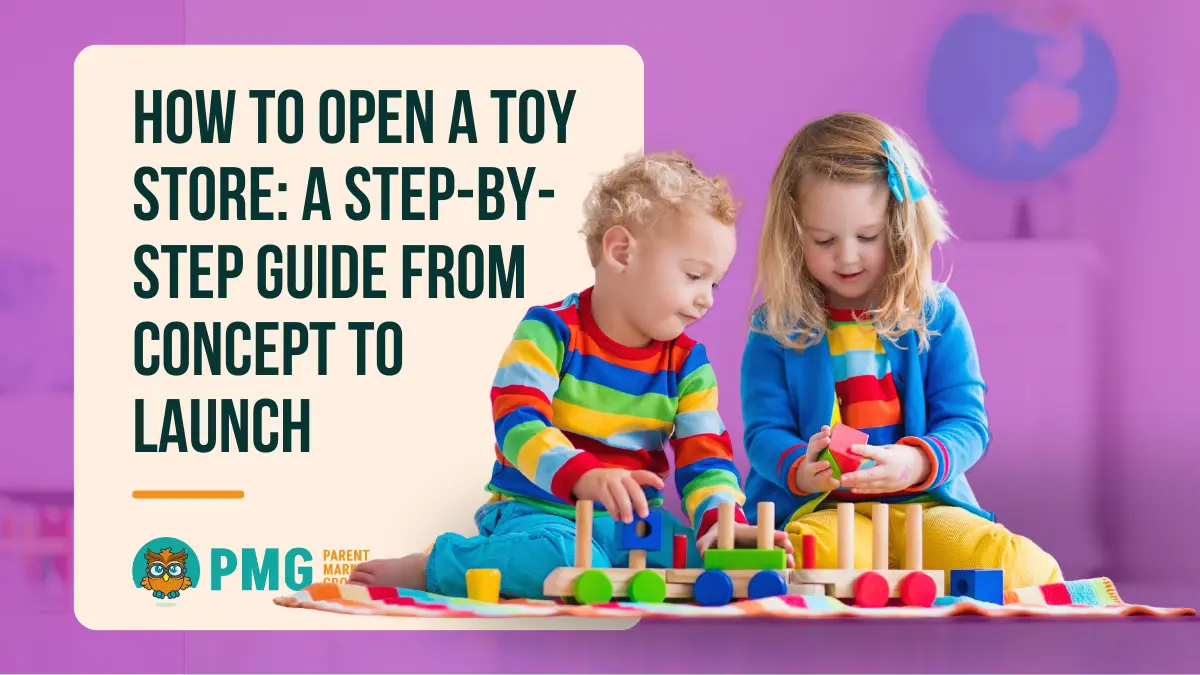How to open a toy store may seem like a playful venture, but it requires careful planning and strategy to succeed. From developing your concept to launching your first store, each step is crucial to building a business that stands out in the competitive retail world.
Whether focusing on niche toys, educational products, or a broad range of playful goods, having a well-thought-out plan will ensure success. In this guide, we’ll walk you through the entire process, from the initial idea to the grand opening of your toy store.
Research and Planning: The Foundation of Opening a Toy Store

The success of opening a toy store relies heavily on strategic research and planning. This phase helps you understand your target market, identify competitors, and create a strong business framework.
- Identify Your Target Audience: Decide whether you’ll focus on specific age groups, types of toys (educational, eco-friendly), or niche markets. Research what families in your area are looking for and how your store can fulfill those needs.
- Analyze the Competition: Visit nearby toy stores to assess their product selection, customer experience, and pricing strategies. Look for gaps where your store can offer something unique.
- Develop a Business Plan: Include your store’s mission, marketing strategy, financial projections, and startup costs. This document is essential for securing funding or investors and guides your business’s growth.
- Establish Your Brand: Choose a memorable name, logo, and theme that appeals to kids and parents. Your branding should create an inviting, playful experience that differentiates your store from competitors.
Through careful research and planning, you can set a solid foundation for your toy store, positioning it for long-term success in the competitive retail market.
Finding the Perfect Location for Opening a Toy Shop ncy
Selecting the right location is critical when opening a toy shop. The ideal spot ensures your store is accessible, inviting, and visible to your target customers—families with children. Here’s how to find that perfect place:
- Consider High-Foot Traffic Areas: Look for locations in busy areas like shopping centers, malls, or schools. These areas naturally draw families, increasing the likelihood of spontaneous visits to your store.
- Accessibility for Families: Ensure your location is accessible by car or public transport. Ample parking is also a must for parents with children. A toy shop near family-friendly businesses, such as ice cream parlors or playgrounds, can be a bonus.
- Evaluate the Neighborhood: The surrounding community plays a vital role. Choose a location in a family-oriented neighborhood where parents and kids frequently shop. Research the demographics to ensure a strong demand for toys and children’s products.
- Visibility and Signage: Opt for a location that offers good visibility from the street. Large windows or prominent signage can help catch the attention of passersby and make your toy shop more inviting.
- Affordability and Lease Terms: Weigh the lease cost against your projected revenue. High-traffic areas might have a higher price tag but often bring more potential customers. Be sure to negotiate favorable lease terms and confirm that the space is big enough to accommodate your inventory and display needs.
Choosing the right location is crucial in opening a toy shop and can significantly affect attracting customers and driving sales.
Legal and Financial Preparations to Open a Toy Store

Before you open a toy store, it’s essential to handle all legal and financial preparations to ensure a smooth launch. Here’s what you need to focus on:
- Business Licenses and Permits: Check with your local government to find out what licenses and permits are required for retail operations. This includes a general business license, sales tax permits, and necessary zoning approvals.
- Choosing a Business Structure: Decide whether your toy store will operate as a sole proprietorship, LLC, or corporation. Each has different implications for taxes, liability, and ownership, so consult with a legal advisor to make the best choice.
- Securing Funding: Estimate your startup costs, which include rent, inventory, and marketing. Then, explore financing options such as personal savings, business loans, or investors. Having a solid financial plan is essential for securing loans and attracting investment.
- Insurance Coverage: Protect your business by obtaining necessary insurance policies, such as general liability insurance, property insurance, and product liability insurance, to cover potential risks.
- Tax and Accounting Setup: Register for an Employer Identification Number (EIN) and set up a tax system for managing sales tax, payroll, and other financial obligations. Hiring an accountant or using accounting software can help you keep your finances organized from the start.
By ensuring that your legal and financial preparations are in order, you can confidently open your toy store and avoid potential hurdles later on. These steps will give you the structure and protection you need to run a successful business.
Curating Your Toy Selection
Choosing the right products is crucial when curating your toy selection for your store. A well-thought-out mix of toys can help attract different customer demographics and encourage repeat business. Here are some critical steps to follow:
- Understand Your Audience: Research what toys your target audience is most interested in. Do your customers want educational toys, classic options, or trendy items? Cater to local demand to ensure your inventory aligns with your customer base.
- Offer a Diverse Range of Products: Include a variety of toys that appeal to different age groups, interests, and price points. Stock a mix of board games, puzzles, action figures, and plush toys, ensuring you have something for everyone.
- Stay Updated on Trends: Monitor industry trends and popular items. Stock trending toys like the latest movie tie-ins, technology-based toys, or eco-friendly options to attract modern parents and kids.
- Balance Quantity and Quality: While filling your store with many options is tempting, too much variety can overwhelm customers. Focus on high-quality toys from reputable brands to build trust and create a positive shopping experience.
- Exclusive or Niche Items: Offering exclusive or hard-to-find toys can set your store apart. This could include locally-made toys, custom items, or limited-edition collections that customers can’t find elsewhere.
By thoughtfully curating your toy selection, you’ll create an appealing mix that satisfies your customers and encourages them to return for more.
Marketing and Promoting Your Toy Store
Effective marketing and promotion are essential to building awareness for your toy store and driving traffic. A solid marketing plan ensures your business stands out and attracts children and parents.
- Utilize Social Media: Platforms like Facebook, Instagram, and Pinterest are perfect for showcasing your products. Share engaging content like new toy arrivals, special offers, and interactive posts that encourage followers to visit your store.
- Host In-Store Events: Organize fun, kid-friendly events like toy demonstrations, themed playdays, or craft workshops. These events excite your store and encourage families to visit in person.
- Email Campaigns and Newsletters: Build an email list to keep customers informed about sales, new products, and exclusive promotions. Offer discounts or giveaways in exchange for email sign-ups to grow your list quickly.
- Collaborate with Local Schools and Groups: Partner with local schools, daycare centers, or parent groups for mutual promotions. This could include offering discounts to their members or sponsoring community events.
- Loyalty Programs: Implement a loyalty program that rewards repeat customers with discounts, exclusive deals, or free toys after reaching a certain number of purchases.
Combining online and offline strategies will promote your toy store and build a strong customer base. Tailor your approach to your audience to ensure your efforts resonate with parents and kids alike.
Grand Opening: Creating Excitement and Buzz

Your grand opening is a key opportunity to generate excitement and attract customers to your new toy store. With the right strategies, you can create a buzz that brings families through your doors and builds anticipation for your products.
- Host Special Events: Plan fun, kid-friendly activities such as face painting, balloon artists, or character appearances. An interactive experience will encourage families to attend and share the event with others.
- Exclusive Discounts and Giveaways: Offer grand opening specials, such as discounts on popular toys or a free gift with purchase. Giveaways or raffles for larger prizes can also incentivize shoppers to visit your store.
- Leverage Social Media and Local Advertising: Promote your event across social media platforms, including Facebook and Instagram. Use countdown posts, sneak peeks, and live updates to build excitement. Place ads in local newspapers or online community groups to reach nearby families.
- Collaborate with Local Influencers: Partner with local bloggers, influencers, or community figures who can spread the word about your grand opening. They can help share your event with a broader audience and give your store added credibility.
- Create a Press Release: Reach out to local media with a press release about your store opening. Highlight what makes your store unique and invite journalists to attend the event, generating additional publicity.
By combining engaging activities, promotions, and strategic marketing, your grand opening will create the excitement and buzz needed to attract your first customers and set your toy store on a path to success.
Partnering with local schools for after-school programs effectively expands your martial arts studio’s reach while providing value to the community. This strategy helps introduce your classes to kids and parents who may not have considered martial arts before.
- Offer Convenient On-Site Classes: Set up martial arts programs at local schools where kids can easily attend right after their regular school day. This provides parents with a convenient option and exposes your studio to a broader audience.
- Collaborate with School Administrators: Work closely with administrators to develop programs that fit the school’s schedule and meet their extracurricular needs. For example, you can offer after-school self-defense or fitness-focused classes tailored to different age groups.
- Exclusive Enrollment Offers: Encourage students who participate in the after-school program to join your studio by offering discounted memberships or a free trial. This is an excellent way to convert after-school participants into long-term students.
- Showcase Student Progress: Organize school-based demonstrations or events where participants can showcase their learning. This gives students a sense of accomplishment and encourages other families to consider enrolling.
By partnering with local schools for after-school programs, you grow your student base and strengthen ties with the community, offering a valuable service to parents and children.
Conclusion
Opening a toy store is an exciting adventure that can bring joy to both children and families while offering the potential for business success. By following the proper steps—planning your concept, curating your inventory, and generating buzz for your grand opening—you’ll be well on your way to creating a thriving business. The right marketing strategies can help your store stand out and attract loyal customers from day one.
Ready to launch your toy store with a brilliant marketing strategy? Contact Parent Marketing today at our contact page or call (706) 899 3707 to get started on the path to success!






